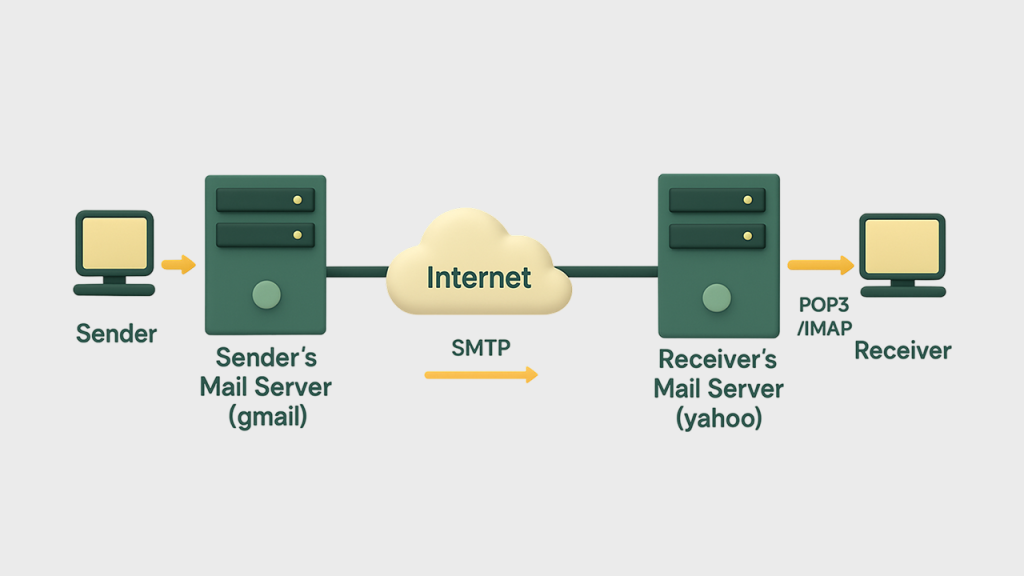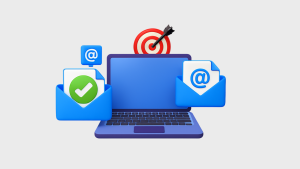- The Digital Postal Service: Understanding SMTP
- The Journey Begins: From Compose to Send
- Security Checkpoints: Authentication and Verification
- The Relay Race: Server to Server Transmission
- The Final Destination: Delivery to Inbox
- When Things Go Wrong: Bounces and Errors
- SMTP in the Modern Era: Evolution and Adaptations
- SMTP’s Critical Role in Email Marketing
- Gamalogic and SMTP Optimization
Few marketers truly appreciate the sophisticated journey their messages undertake—traveling from outbox to inbox. Behind every “whoosh” sound effect or satisfying ping of a sent email lies an intricate process powered by a protocol that’s been the backbone of electronic communication for over four decades: Simple Mail Transfer Protocol (SMTP).
The Digital Postal Service: Understanding SMTP
SMTP functions as the internet’s postal service, facilitating the reliable transfer of your emails across various networks, servers, and security checkpoints. Developed in 1982 by the Internet Engineering Task Force, this protocol has withstood the test of time, evolving alongside the internet while maintaining its core functionality.

At its essence, SMTP is a set of commands that email servers use to communicate with each other. When you hit “send” on an email, SMTP takes over, initiating a sequence of handshakes and data transfers that ensure your message reaches its intended destination.
The Journey Begins: From Compose to Send
The journey of an email starts the moment you finish composing your message and click “send.” At this point, your email client (whether Gmail, Outlook, or another service) connects to an SMTP server. This connection typically uses port 25 for unencrypted communications, or more commonly today, port 587 for encrypted connections using TLS/SSL.
Your email client introduces itself to the SMTP server through a process called the “SMTP handshake,” which involves a series of commands:
- HELO/EHLO: Your client greets the server and identifies itself
- MAIL FROM: Your client specifies who’s sending the email
- RCPT TO: Your client declares who should receive the email
- DATA: Your client indicates it’s ready to transmit the actual message content
This handshake provides the server with essential routing information—essentially addressing the digital envelope that will carry your message.
Security Checkpoints: Authentication and Verification
In today’s security-conscious digital environment, emails rarely proceed without proper verification. Modern SMTP implementations include various authentication mechanisms to prevent spam and email forgery:
Sender Authentication
Before accepting your outgoing message, the SMTP server typically verifies your identity through one of several methods:
- Username/password authentication: The standard login credentials you set up with your email provider
- SMTP AUTH: A more secure extension allowing various authentication mechanisms
- OAuth2: An authorization framework used by major providers like Google and Microsoft
Email Validation
The server performs several checks on your message:
- Syntax verification: Ensuring email addresses are properly formatted
- Domain validation: Confirming the sender’s domain exists
- SPF (Sender Policy Framework) checks: Verifying the sending server is authorized to send mail for that domain
- Rate limiting: Checking that you haven’t exceeded sending quotas
These checkpoints help maintain the integrity of email systems by preventing malicious actors from abusing the network.
The Relay Race: Server to Server Transmission
Once your email passes initial validation, the real journey begins. Like a baton in a relay race, your message may pass through multiple SMTP servers before reaching its destination.
DNS Resolution and MX Records
Your outgoing SMTP server needs to locate the recipient’s mail server. It does this by performing a DNS lookup for the MX (Mail Exchange) records of the recipient’s domain. MX records specify which mail servers are responsible for accepting email for that domain, along with their priority levels.
For example, if you’re sending an email to someone@example.com, your SMTP server queries DNS for the MX records of example.com. The response might indicate that mail.example.com is responsible for receiving emails for that domain.
SMTP Conversations Between Servers
Your outgoing server establishes a connection with the recipient’s mail server and initiates another SMTP handshake similar to the one your email client performed earlier. The two servers exchange information about the sender, recipient, and message size.
At this point, several more security checks may occur:
- DKIM (DomainKeys Identified Mail) verification: Checking cryptographic signatures to ensure the email hasn’t been tampered with during transit
- DMARC (Domain-based Message Authentication, Reporting, and Conformance) policy enforcement: Determining how to handle messages that fail authentication checks
- Reputation checks: Evaluating the sending server’s history and reliability
- Content filtering: Scanning for potential spam or malicious content
If any of these checks fail, your message might be rejected, quarantined, or flagged as suspicious.
The Final Destination: Delivery to Inbox
Assuming all checks pass successfully, the recipient’s mail server accepts your message and stores it until the recipient connects to retrieve their mail. This final stage typically involves a different protocol—either POP3 (Post Office Protocol) or IMAP (Internet Message Access Protocol)—which governs how email clients retrieve messages from servers.
When the recipient opens their email client, it connects to their mail server using POP3 or IMAP, downloads new messages, and displays them in the inbox. The journey is complete.
When Things Go Wrong: Bounces and Errors
Not all email journeys end successfully. Various factors can interrupt the process:
Soft Bounces
Temporary issues that may resolve with time:
- Recipient’s mailbox is full
- Recipient’s mail server is temporarily unavailable
- Message size exceeds limits
- Rate limiting or greylisting is in effect
In these cases, the sending server typically attempts redelivery several times over a period of hours or days before giving up.
Hard Bounces
Permanent failures that won’t be resolved with retries:
- Recipient email address doesn’t exist
- Recipient domain doesn’t exist
- Sending IP or domain is blacklisted
- Content is definitively identified as spam
When a hard bounce occurs, the sending server generates a bounce message—an email notification explaining why delivery failed—and returns it to the sender.
SMTP in the Modern Era: Evolution and Adaptations
While SMTP’s core functionality remains largely unchanged, the protocol has evolved significantly to address modern email challenges:
Security Enhancements
- STARTTLS: Allows encryption of SMTP connections, protecting messages from eavesdropping
- SMTP AUTH: Provides secure authentication mechanisms
- Various anti-spoofing standards: SPF, DKIM, and DMARC help verify sender authenticity
Extended Functionality
- ESMTP (Extended SMTP): Adds support for multimedia content, internationalized addresses, and delivery notifications
- SMTPS: Fully encrypted SMTP sessions using TLS/SSL
- Submission ports: Dedicated ports (587 for message submission) to separate different types of email traffic
SMTP’s Critical Role in Email Marketing
For marketers, SMTP isn’t just a technical protocol—it’s the foundation of successful email marketing campaigns. Understanding how SMTP works enables marketers to optimize deliverability and maximize ROI from email initiatives.
Deliverability: The Cornerstone of Email Marketing Success
Email deliverability—the ability to reach subscribers’ inboxes rather than spam folders or being blocked entirely—depends largely on proper SMTP implementation:
SMTP Authentication and Email Marketing
Proper authentication is non-negotiable for marketing emails:
- SPF Records: Define which servers are authorized to send emails from your domain
- DKIM Signatures: Add a digital signature to verify your emails haven’t been tampered with
- DMARC Policies: Instruct receiving servers how to handle emails that fail authentication
Marketing platforms that implement these authentication methods experience significantly higher deliverability rates—often 10-20% higher than those without proper authentication.
SMTP Relay Services for Marketing Campaigns
Many email marketing platforms leverage specialized SMTP relay services that offer:
- High-volume capacity: Ability to send thousands or millions of emails efficiently
- IP reputation management: Maintaining clean IP addresses dedicated to marketing emails
- Automatic throttling: Adjusting sending rates to meet receiver requirements
- Advanced analytics: Tracking delivery, opens, clicks, and other engagement metrics
These relay services build relationships with major inbox providers (Gmail, Yahoo, Outlook) to maintain preferential delivery paths for legitimate marketing emails.
SMTP Performance Metrics in Email Marketing
Successful email marketers closely monitor several SMTP-related metrics:
- Delivery Rate: Percentage of emails accepted by receiving SMTP servers
- Inbox Placement Rate: Percentage of delivered emails reaching the inbox (vs. spam folder)
- Bounce Rate: Percentage of emails rejected by receiving SMTP servers
- Deferral Rate: Percentage of emails temporarily rejected but later accepted
- Complaint Rate: Percentage of delivered emails marked as spam by recipients
Industry benchmarks suggest maintaining bounce rates below 2% and complaint rates below 0.1% to preserve good sender reputation.
Warming Up SMTP IPs for Marketing Success
When launching new email marketing initiatives, proper “IP warming” is essential:
- Gradual volume increase: Starting with small batches (hundreds) and slowly scaling to full volume over 4-6 weeks
- Segmentation by engagement: Initially sending to highly engaged subscribers who are likely to open and click
- Consistent sending patterns: Establishing predictable sending volumes and schedules
- Content quality control: Ensuring initial campaigns contain high-quality, engaging content that encourages positive recipient actions
Email marketers who follow proper warming protocols typically see 30-40% higher deliverability rates during the crucial initial months of a campaign compared to those who immediately send at full volume.
Gamalogic and SMTP Optimization
A critical component of successful email marketing is ensuring your contact list contains valid, deliverable addresses before initiating the SMTP sending process. This is where specialized email validation services like Gamalogic come into play.
Gamalogic Email Validation: Enhancing SMTP Efficiency
Gamalogic provides comprehensive email validation services that work alongside SMTP processes to dramatically improve deliverability metrics. By validating email addresses before they enter the SMTP pipeline, Gamalogic helps marketers:
Multi-Layer Validation Approach
Gamalogic’s email validation service implements a sophisticated multi-step verification process that mimics SMTP transactions to predict deliverability:
- Syntax Verification: Ensuring email addresses follow proper format rules (e.g., containing a valid username, @ symbol, and domain)
- Domain Existence Check: Confirming the domain exists and has valid DNS records
- MX Record Validation: Verifying the domain has functioning mail exchange servers
- SMTP Connection Test: Establishing a connection with the recipient’s mail server without actually sending an email
- Mailbox Verification: Using proprietary technology to confirm the specific mailbox exists without triggering spam flags
- Disposable Email Detection: Identifying temporary or throwaway email addresses that have low engagement value
- Role Account Identification: Flagging generic addresses (info@, support@, etc.) that typically have lower response rates
Real-time API Integration with SMTP Systems
Gamalogic’s API seamlessly integrates with leading email marketing platforms and SMTP services, allowing for:
- Real-time validation: Verify addresses at the point of collection before they enter your database
- Batch processing: Clean existing lists before major campaign launches
- Scoring system: Assign deliverability probability scores to each address for segmentation purposes
- Detailed reporting: Receive comprehensive analytics on list quality and potential deliverability issues
Measurable Benefits for Email Marketers
Organizations implementing Gamalogic’s validation service in conjunction with optimized SMTP practices typically experience:
- Reduced bounce rates: Average 60% decrease in hard bounces compared to unvalidated lists
- Improved sender reputation: Fewer bounces lead to better IP and domain reputation scores
- Higher engagement metrics: Cleaner lists result in more accurate engagement measurements
- Cost savings: Lower sending volumes as invalid addresses are removed before sending
- Enhanced deliverability: Average 15-25% improvement in inbox placement rates
- Spam complaint reduction: Typically 40-50% fewer spam complaints when sending to validated lists
Integration into the SMTP Workflow
Gamalogic’s verification services enhance the email journey at critical points:
- Pre-sending validation: Identifying and removing problematic addresses before they enter the SMTP pipeline
- List hygiene automation: Scheduling regular validation passes to maintain list quality over time
- Triggered validation workflows: Automatically validating addresses after period of inactivity
- Suppression list management: Creating and maintaining suppression lists for addresses that could damage sender reputation
By implementing these validation processes before emails enter the SMTP journey, marketers can ensure their messages are routed more efficiently and reach more inboxes.
Post your Comment.
You might also like

How to Maximize Your Email Marketing with Integrated CRM Capabilities
By integrating your CRM with your email marketing platform, you unlock powerful personalization, automation, and real-time targeting that drives engagement and revenue. From dynamic content to behavioral triggers and unified reporting, CRM-powered email campaigns connect smarter with your audience—boosting ROI, efficiency, and customer satisfaction.

Email Marketing Under Transformation: The Reshaping Power of Data Quality
Poor data quality not only hinders your ability to reach the right audience but can also tarnish your brand's reputation and lead to costly consequences. In this article, we'll explore the importance of data quality, common quality issues, and strategies to ensure your email marketing efforts are fueled by informed decisions based on accurate and reliable data.

Cold Email Isn’t the Same Game Anymore
Cold email isn’t what it used to be. Discover why old outreach tactics no longer work and learn how to adapt your cold email strategy for today’s inbox.






 No credit card required
No credit card required


I enjoyed reading this article. Thanks for sharing your insights.